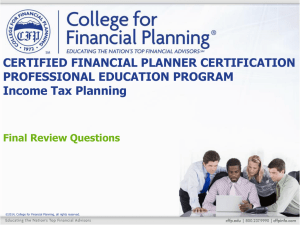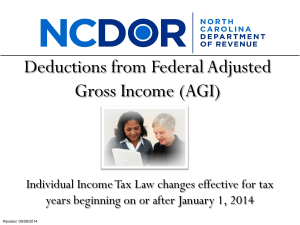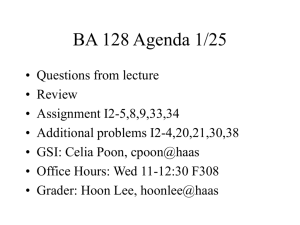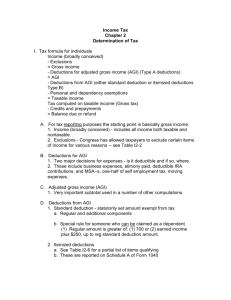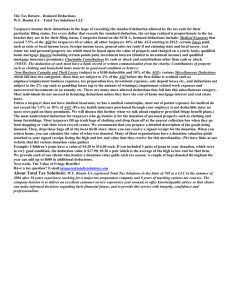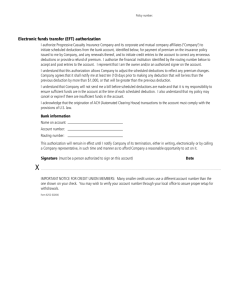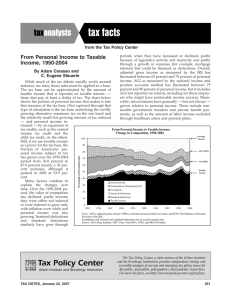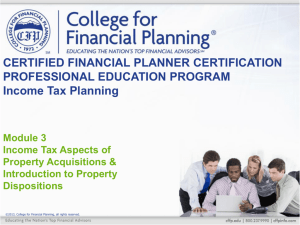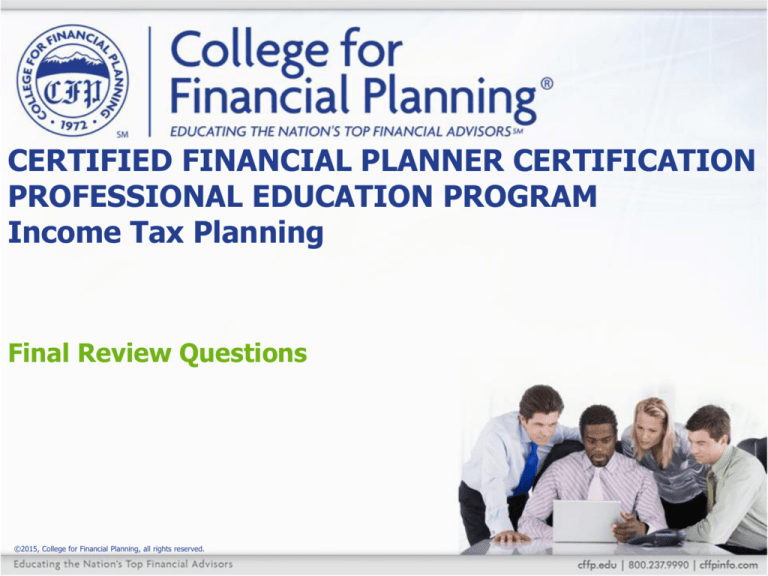
CERTIFIED FINANCIAL PLANNER CERTIFICATION
PROFESSIONAL EDUCATION PROGRAM
Income Tax Planning
Final Review Questions
©2015, College for Financial Planning, all rights reserved.
Information Provided (2015)
• Personal exemptions are $4,000.
• Standard deduction amounts are:
Single: $6,300
Head of household: $9,250
Married filing jointly: $12,600
Married filing separately: $6,300
Individuals eligible to be claimed as
dependent: $1,050
AOTC, Lifetime, and Coverdell phaseouts
Individual & Corporate Tax rate schedules
MACRS table
o
o
o
o
o
•
•
•
Review Question 1
Cost recovery recapture is the amount of
a. long-term capital gain on the sale of Section
1245 property.
b. ordinary income from the sale of depreciated
real estate.
c. long-term capital gain from the sale of
depreciated real estate.
d. ordinary income from the sale of Section
1245 property.
Review Question 2
Fred and April Johnson are married and file a
joint income tax return. During the current tax
year, Fred and April will make deductible IRA
contributions of $3,000. They are in a 28%
marginal income tax bracket.
What amount of tax savings will be generated
by this deduction?
a. $840
b. $2,160
c. $3,000
d. $4,167
Review Question 3
The following summarizes several financial events in the
life of James Grant during the current tax year:
• He received a $100,000 inheritance.
• He had gambling winnings of $50,000.
• He had itemized deductions of $10,000.
• Received $4,000 of workers’ compensation
proceeds.
What is his total income for the current tax year?
a. $40,000
b. $50,000
c. $100,000
d. $144,000
Review Question 4
Lowell and Thelma Jordan are married and will file a joint return
for the current tax year. Both participate in their employers’ 401(k)
plans. They have provided you with the following information:
• Lowell’s salary:
$60,000
• Thelma’s salary:
$25,000
• Unemployment compensation:
$10,000
• Net capital loss:
$8,000
• Limited partnership loss:
$5,000
• IRA contributions:
$11,000
Based on the information given, what is Lowell and Thelma’s
adjusted gross income for the current tax year?
a. $77,000
b. $81,000
c. $82,000
d. $87,000
Review Question 5
John and Mary West, ages 42 and 38, respectively, are married
taxpayers filing jointly. They have itemized deductions consisting of
the following:
• Home mortgage interest:
$17,000
• State income taxes:
$2,400
• Property taxes:
$1,600
• Charitable contributions:
$2,200
• Tax preparation fees:
$550
• Medical expenses
$5,000
John and Mary’s AGI for 2015 is $346,700. What is the amount of
allowable itemized deductions?
a. $22,096
b. $23,200
c. $27,596
d. $28,700
Review Question 6
Which one of the following may be allowed as a
like-kind exchange?
a. a heifer exchanged for a bull
b. an apartment building located in Miami
exchanged for an apartment building located
in Mexico City
c. farming equipment exchanged for farmland
d. a shopping center exchanged for farmland
Review Question 7
Which of the following are characteristics of a C
corporation?
I. The number of shareholders is limited.
II. The bankruptcy of shareholders has no effect on
the business form.
III. Shareholder liability is limited.
IV. Capital structure is dependent upon the resources
of the shareholders.
a. I and II only
b. I and IV only
c. II and III only
d. II and IV only
e. III and IV only
Review Question 8
Three years ago, Jack Martin purchased a duplex for
investment purposes at a cost of $185,000. Legal fees
for acquisition and capital improvements before renting
the property totaled $15,000. He has since taken cost
recovery deductions in the amount of $21,500 and paid
$5,500 in property taxes. He also paid $850 for repairs
last year.
What is Jack’s current adjusted basis in the duplex?
a. $163,500
b. $178,500
c. $179,350
d. $184,000
e. $184,850
Review Question 9
Sal Boyd has AGI of $300,000. Included in the AGI is
$33,000 of passive income from a publicly-traded limited
partnership. Sal is considering several investment
alternatives. He would prefer an investment that will help
to reduce his income tax liability. Which one of the
following investments has the greatest potential for
reducing Sal’s tax liability?
a. an oil and gas limited partnership (not publicly traded)
that is generating losses
b. a publicly-traded limited partnership producing passive
losses
c. a historic rehabilitation limited partnership producing
tax credits
d. a low-income housing activity placed in service in 2005
that is producing credits
Review Question 10
Edgar Hammond, a commissioned salesperson and single
taxpayer, has provided the following information for the
current tax year.
• Edgar’s sales commissions
$60,000
• Keogh contribution
$ 6,000
• Alimony paid to Edgar’s former wife
$12,000
• Qualified moving expenses
$ 3,000
• Self-employment tax
$ 8,478
• Property taxes
$ 3,500
What is Edgar’s adjusted gross income for the current tax
year?
a. $30,522
b. $34,761
c. $37,761
d. $54,000
Review Question 11
Frank Farmer owns a warehouse that has a fair market
value of $150,000 and an adjusted basis of $60,000. He
wants to acquire Mary Pierce’s apartment building,
which has a fair market value of $200,000 and an
adjusted basis of $180,000. In the contemplated
exchange, Frank will pay Mary $50,000.
What is the amount of gain or loss, if any, realized by
Frank in the exchange?
a. ($20,000)
b. $0
c. $30,000
d. $70,000
e. $90,000
Review Question 12
Frank Farmer owns a warehouse that has a fair market
value of $150,000 and an adjusted basis of $60,000. He
wants to acquire Mary Pierce’s apartment building,
which has a fair market value of $200,000 and an
adjusted basis of $180,000. In the contemplated
exchange, Frank will pay Mary $50,000.
What is the amount of gain or loss, if any, recognized
by Frank in the exchange?
a. ($20,000)
b. $0
c. $30,000
d. $70,000
e. $90,000
Review Question 13
Frank Farmer owns a warehouse that has a fair market
value of $150,000 and an adjusted basis of $60,000. He
wants to acquire Mary Pierce’s apartment building,
which has a fair market value of $200,000 and an
adjusted basis of $180,000. In the contemplated
exchange, Frank will pay Mary $50,000.
What is Frank’s substitute basis in the acquired
apartment building?
a. $60,000
b. $110,000
c. $150,000
d. $160,000
e. $200,000
Review Question 14
Warren Peace owns and operates a bookstore as a sole
proprietorship. During January of the current year, he
purchased and placed into service office equipment (7year property) with a cost of $13,300 plus sales tax of
$700. The equipment will be used exclusively in the
business.
Assume Warren chooses to use the straight-line option
under MACRS. What is the cost recovery deduction for
the current year?
a. $950
b. $1,000
c. $1,330
d. $1,900
e. $2,000
Review Question 15
Warren Peace owns and operates a bookstore as a sole
proprietorship. During January of the current year, he
purchased and placed into service office equipment (7year property) with a cost of $13,300 plus sales tax of
$700. The equipment will be used exclusively in the
business.
What is Warren’s adjusted basis in the equipment after
year 1?
a. $11,400
b. $11,970
c. $12,000
d. $12,350
e. $13,000
Review Question 16
Warren Peace owns and operates a bookstore as a sole
proprietorship. During January of the current year, he
purchased and placed into service office equipment (7-year
property) with a cost of $13,300 plus sales tax of $700. The
equipment will be used exclusively in the business.
Assume that Warren sells the office equipment for $15,500
after claiming $6,000 of cost recovery deductions.
What is the amount, if any, of cost recovery deductions that
must be recaptured under Section 1245?
a. $0
b. $1,500
c. $6,000
d. $7,500
e. $8,000
Review Question 17
Warren Peace owns and operates a bookstore as a sole
proprietorship. During January of the current year, he
purchased and placed into service office equipment (7-year
property) with a cost of $13,300 plus sales tax of $700. The
equipment will be used exclusively in the business.
Assume that Warren sells the office equipment for $15,500
after claiming $6,000 of cost recovery deductions. What
amount, if any, would be considered a Section 1231 gain?
a. $0
b. $1,500
c. $2,200
d. $6,000
e. $7,500
Review Question 18
Steve and Allison Parker, a married couple in their 40s,
file a joint return.
• They earned combined salaries of $165,000.
• They received dividend and interest income of $460
from mutual funds.
• They have itemized deductions of $9,750.
• They have net capital losses of $5,200.
• They have two children, ages 12 and 14.
What is their taxable income for the 2015 tax year?
a. $132,060
b. $132,660
c. $133,860
d. $136,910
Review Question 19
Which one of the following best describes the
role of the substantial economic effect doctrine?
a. It allows the IRS to tax certain partnerships
as if they were corporations.
b. It limits the ability to use special allocations.
c. It limits the ability to deduct limited
partnership losses.
d. It limits the advantage gained through
leverage.
e. It requires that the at-risk rules be satisfied.
Review Question 20
During the current tax year, Jim Vale has
$10,000 of passive income from a publicly
traded limited partnership. He also has a nonpublicly traded limited partnership that will
generate a $10,000 passive loss.
How much of this passive loss, if any, is
deductible by Jim during the current tax year?
a. $0
b. $1,000
c. $3,000
d. $10,000
Review Question 21
Which one of the following is not an advantage
of the cash basis method of accounting?
a. Taxes are not paid until income is received.
b. Taxpayers can keep simple records.
c. Taxpayers can control each year’s receipts
and payouts.
d. Constructive receipt serves to defer income.
Review Question 22
In the current tax year, Ken Bush sold several securities that
left him with the following types of gains and losses:
• long-term capital gain—$8,000
• short-term capital gain—$800
• long-term capital loss—$2,200
• short-term capital loss—$1,200
What is the net capital gain or loss on Ken’s security sales?
a. net short-term loss of $5,400
b. net long-term gain of $5,400
c. net long-term gain of $5,800 and net short-term loss of
$400
d. net long-term gain of $6,800 and net short-term gain of
$3,400
e. net long-term gain of $8,800 and net long-term loss of
$3,400
Review Question 23
Kris Swenson anticipates adjusted gross income of $100,000
during the current tax year. She is considering making a gift
of appreciated real estate to the university she attended,
Sinton Tech, a qualified charitable institution. Kris’s adjusted
basis in this real estate is $40,000. The real estate has a
current fair market value of $50,000. Kris has owned the real
estate for six months.
If Kris does gift the real estate to Sinton this year, what is
the maximum allowable charitable deduction Kris can receive
for the current tax year?
a. $20,000
b. $30,000
c. $40,000
d. $50,000
e. $100,000
Review Question 24
Which of the following are preference items or
adjustments for purposes of the individual alternative
minimum tax?
I. Interest on a qualified private-activity municipal
bond issued in 2008
II. the excess of percentage depletion over the
property’s adjusted basis
III. investment interest expense in excess of net
investment income
IV. qualified housing interest
a. I only
b. II only
c. I and II only
d. II and III only
e. I, II, III, and IV
Review Question 25
Sam Smith had the following items of income during the
current tax year:
• Sole proprietorship net income
$25,000
• General partnership flow-through
$5,000
• Interest income
$2,000
• Flow-through of S corporation income $10,000
What is the amount of self-employment tax Sam owes?
a. $4,239
b. $4,590
c. $5,652
d. $6,426
Review Question 26
Keith Pierce recently was divorced from his wife,
Barbara. Barbara received custody of their two
children. Keith was ordered to pay $1,000 per
month to Barbara until the youngest child reaches
age 18. At that time, the payments are to decrease
to $400 per month.
What portion, if any, is deductible by Keith as
qualifying alimony?
a. $0
b. $400
c. $500
d. $600
e. $1,000
Review Question 27
MNO Corporation has the following items of income and expense:
• Taxable income
$330,000
• Federal income tax
$100,000
• Dividends paid in current year
$20,000
• Accumulated earnings and profits at
the end of the preceding tax year
$60,000
• Assume MNO is not a service corporation and cannot establish
a valid business purpose for its excess accumulations.
What is the amount of accumulated earnings tax payable?
a. $0
b. $4,000
c. $24,000
d. $42,000
Review Question 28
This year, Ryan Nolan sold a classic automobile to his
neighbor, Kevin Kennedy, on the following terms:
• The price was $18,000, equal to the fair market
value.
• Ryan’s basis in the automobile was $9,000.
• Kevin will make a $3,000 down payment this year.
• Kevin will pay in six annual installments of $2,500
plus accrued interest.
Kevin made the first installment payment this year.
Ignoring interest income, what amount of gain will Ryan
recognize for the current year?
a. $1,250
b. $2,750
c. $9,000
d. $18,000
Review Question 29
During the current tax year, Jim Johnson purchased a warehouse
for exclusive use in his manufacturing business. The cost of the
property was $170,000, of which $40,000 was attributable to the
land.
Which of the following statements identify the proper treatment
of the expenditure?
I. A portion of the $130,000 attributable to the building may be
deducted under Section 179.
II. The $40,000 attributable to the land must be capitalized and
may not be depreciated.
III. The $130,000 attributable to the building must be capitalized
and depreciated.
IV. The entire $170,000 must be capitalized and depreciated.
a. II only
b. III only
c. IV only
d. I and II only
e. II and III only
Review Question 30
During the current tax year, Paul Hall has the following items from
his four investments:
Passive income from a publicly traded limited partnership
$15,000
Passive loss from a publicly traded limited partnership
$10,000
Passive income from a nonpublicly traded limited
partnership
Passive loss from a nonpublicly traded limited partnership
$8,000
$16,000
What is the total amount, if any, of passive losses that may be
deducted during the current year?
a. $0
b. $8,000
c. $10,000
d. $16,000
e. $26,000
Review Question 31
During June of 2015, Judy Hall, a sole proprietor,
purchased new equipment (7-year property) for her
offices at a cost of $30,000. She also paid sales
taxes and setup charges of $2,000. Assume she
elects and qualifies for the maximum Section 179
deduction and uses MACRS.
What is the maximum first-year deduction that Judy
may claim with respect to the equipment?
a. $25,000
b. $26,000
c. $30,000
d. $32,000
Review Question 32
Maxwell Gates is about to begin receiving payments
from a deferred fixed annuity that he purchased many
years ago. His investment in the annuity contract was
$30,000. He is to receive $375 per month for the rest of
his life. His current life expectancy, based on IRS tables,
is 10 years.
What amount, if any, of each monthly payment is
excludible by Maxwell?
a. $0
b. $125
c. $150
d. $250
e. $375
Review Question 33
Tom Bell has investment income (interest) of
$8,000 in the current year. He paid $1,200 in
commissions and had $7,000 of investment
interest expense. His AGI is $35,000.
What amount of investment interest expense
may be deducted in the current year as an
itemized deduction?
a. $6,500
b. $6,800
c. $7,000
d. $7,500
e. $8,000
Review Question 34
In March of the current year, Susan Sharp sold
her principal residence for a total price of
$408,000. Susan purchased the home 14 years
ago for $50,000. She made $20,000 of
improvements to the house. She paid Realtor
commissions of $23,000 on the sale.
What amount, if any, must be recognized on
the sale of Susan’s residence?
a. $65,000
b. $85,000
c. $108,000
d. $315,000
Review Question 35
Which one of the following statements is
accurate with respect to a like-kind exchange?
a. Gain recognized is equal to the gain realized
on the exchange plus the boot received.
b. The amount of gain recognized will reduce
the taxpayer’s basis in the property received.
c. No gain will be recognized on the exchange
of inventory.
d. No gain will be recognized unless the
taxpayer receives boot.
Review Question 36
Assume a taxpayer is faced with a tax
deficiency of $8,000, along with interest on the
deficiency of $3,000. The entire deficiency
resulted from intentional concealment of her
income.
What is the amount of the penalty?
a. $1,600
b. $2,200
c. $6,000
d. $8,250
Review Question 37-40
For questions 37 through 40, match the
expenditures with the descriptions. Use only one
answer per blank. Each answer may be used more
than once or not at all.
a. deduction from AGI
b. deduction for AGI
c. no tax benefit
d. tax credit
37.
38.
39.
40.
interest paid on personal credit card
child support paid
gambling losses to extent of gambling
winnings
qualified historic rehabilitation expenditures
Review Question 41-44
For questions 41 through 44, match the potential
tax benefits with the rules or doctrines that may
limit those benefits. Use only one answer per blank.
Each answer may be used more than once or not at
all.
a. active participation standards
b. substantial economic effect doctrine
c. at-risk rules
d. alternative minimum tax
41.
42.
43.
44.
leverage
tax credits
special allocations
accelerated cost recovery deductions
Review Question 45
Francine and Marshall Wild have three children;
Bill, Curt, and Rachel. For 2015:
• Bill, age 11, has $1,800 of interest income
• Curt, age 13, has $2,950 of salary from a
part-time job
• Rachel, age 19 and not a full-time student,
has $5,100 of dividends and capital gains
Whose income is subject to the kiddie tax?
a. Bill only
b. Curt only
c. Bill and Rachel only
d. none of the children
Review Question 46
Matthew Brady, age 47, purchased a deferred
annuity in January 1981 for $50,000. In the current
year, when the surrender value was $125,000,
Matthew received a nonperiodic payment of
$75,000. The payment was prior to the annuity
starting date.
Which of the following statements correctly
describe the income tax consequences of the
distribution?
a. $75,000 is tax free.
b. $75,000 is taxable income.
c. $50,000 is tax free, $25,000 is taxable.
d. $50,000 is taxable, $25,000 is tax free.
Review Question 47
Which one of the following is a characteristic of
an S corporation?
a. There may be no more than 25
shareholders.
b. There may be no more than two classes of
stock.
c. A simple majority of shareholders must
consent to the election.
d. All shareholders must be U.S. citizens or
residents or be one of certain qualifying
trusts.
e. The shareholders have personal liability for
the acts of the S corporation.
Review Question 48
Frank Johnson operates a sole proprietorship
from his apartment. His gross income for the
current tax year is $24,000. Business expenses
not associated with his home office total
$22,000. Expenses associated with the home
office total $2,750.
How much of the home-office expense, if any,
may Frank deduct for the current year?
a. $0
b. $275
c. $2,000
d. $2,750
Review Question 49
During 2015, Bill Jeffers purchased several items of
depreciable, tangible personalty, with a total cost of
$175,000, for use in his sole proprietorship. Bill has
taxable (earned) income from his business of
$11,000 (without regard to the Section 179
expense). He also has wages from a part-time job
of $5,000.
What is the maximum amount of Section 179
expense that Bill may deduct in the current year?
a. $11,000
b. $16,000
c. $25,000
d. $175,000
Review Question 50
Two years ago, Morton Andreson purchased equipment
(seven-year property) for use in his business at a cost
of $12,000. Cost recovery deductions total $7,392. The
equipment was sold for $13,000.
What is the amount and nature of the gain resulting
from the sale?
a. $1,000 long-term capital gain
b. $4,608 cost recovery recapture
c. $7,392 Section 1231 gain, $1,000 Section 1245
income
d. $7,392 cost recovery recapture, $1,000 Section 1231
gain
Review Question 51
During the current year, Chuck Langston has Section 1231
gains totaling $14,000. He also has $3,000 of Section
1231 losses. Four years ago, Chuck reported a net Section
1231 loss of $7,000. These are the only two years in
which Chuck has had Section 1231 gains or losses.
What is the character of the current year’s Section 1231
gains and losses?
a. $4,000 long-term capital gain
b. $4,000 ordinary income, $7,000 long-term capital gain
c. $7,000 ordinary income, $4,000 long-term capital gain
d. $7,000 long-term capital gain
e. $11,000 long-term capital gain
Review Question 52
Phillip Hunter’s personal automobile was almost
destroyed in an accident. The insurance company
paid $6,000 on the claim. The auto’s fair market
value before the accident was $16,000, and the
value after the accident is $1,000. His basis in the
automobile is $12,000. Phillip’s AGI is $42,500.
What is the amount of Phillip’s deductible casualty
loss?
a. $1,650
b. $1,750
c. $6,000
d. $15,000
Review Question 53
Edward Coleman had the following capital transactions
during the current year:
• long-term capital gain: $3,200
• long-term capital loss: ($3,600)
• short-term capital gain: $4,500
• short-term capital loss: ($3,400)
Which one of the following describes the net capital gain
or loss reportable by Edward for the current tax year?
a. $700 net short-term capital gain
b. $1,100 net short-term capital gain, $400 net long-term
capital loss
c. $900 net short-term capital gain, $200 net short-term
capital loss
d. $7,700 net capital gain, $7,000 net capital loss
Review Question 54
Which one of the following is not a requirement
to be met in order to deduct alimony payments?
a. Payments must be in cash.
b. The parties must not live together or file a
joint tax return at the time of payment.
c. The legal document or state law must
require that payments will stop after the
recipient spouse dies.
d. Payments must be received by or for the
benefit of the payee spouse.
e. Payments must be equal in each year of the
agreement.
Review Question 55
Which of the following are considered advantages
of direct participation programs?
I. leverage
II. tax conduit
III. special allocations
IV. substantial economic effect
a. I only
b. I and II only
c. II and IV only
d. I, II, and III only
e. I, II, III, and IV
Review Question 56
Melanie MacMillin owns and operates a retail appliance store with
annual sales of approximately $800,000. The store also specializes in
repairing appliances. Approximately 80% of her sales are with
extended credit terms.
What method of tax accounting may be used for Melanie’s business?
I. the accrual method, because inventory is such a large
component of the business
II. the cash method, because it provides flexibility in the timing of
income and expenses
III. the hybrid method, because the business involves both inventory
and service
IV. the installment sale method, to spread the gain over a longer
time frame
a. I only
b. III only
c. I, II, and III only
d. I, II, III, and IV
Review Question 57
Which one of the following is a correct
statement regarding the LIFO method of
accounting for inventory?
a. During periods of declining inventory prices,
lower taxable income will result.
b. During periods of declining inventory prices,
the cost of goods sold (COGS) will be higher.
c. During periods of increasing inventory prices,
lower taxable income will result.
Review Question 58
Kris Swenson anticipates adjusted gross income of
$100,000 during the current tax year. She is
considering making a gift of a coin collection to her
church. Kris’s adjusted basis in this coin collection is
$10,000. The collection has a current fair market
value of $60,000. Kris has owned collection for six
years.
What is the maximum allowable charitable
deduction Kris can receive for the current tax year?
a. $10,000
b. $18,000
c. $30,000
d. $60,000
Review Question 59
Which one of the following is correct regarding the
amount of estimated tax payments and withholding a
taxpayer must pay to avoid an "underpayment of
estimated tax" penalty? Assume that the prior year AGI
was less than $150,000.
a. the lesser of 80% of the current year's tax liability or
90% of the prior year's total tax
b. the lesser of 90% of the current year's tax liability or
90% of the prior year's total tax
c. the lesser of 90% of the current year's tax liability or
100% of the prior year's total tax
d. the lesser of 90% of the current year's tax liability or
110% of the prior year's total tax
Review Question 60
A Treasury regulation is
a. a general administrative interpretation of
statutory tax law.
b. the source of statutory tax law.
c. an administrative interpretation of statutory
tax law that is generally related to specific
circumstances of fact.
d. an administrative interpretation of statutory
tax law that is generally related to
compliance issues.
Review Question 61
Which one of the following is not a relief
provision that applies to federal income
taxation?
a. exclusion for life insurance proceeds received
b. Section 179 expense election
c. child care credit
d. additional standard deduction for the elderly
or blind
Review Question 62
Which of the following is not a step in the tax
calculation process?
a. determine gross income
b. subtract adjustments to income from gross
income to get adjusted gross income
c. deduct the greater of itemized deductions or
the standard deduction
d. determine the personal exemption amount
that can be deducted
e. subtract exclusions from the adjusted gross
income
Review Question 63
Three years ago, John McDougal received a gift
of 100 shares of common stock from his uncle.
The fair market value of the stock on the date
of the gift was $12 per share. His uncle had
purchased the stock four years earlier at $5 per
share. John sold this stock for $17 per share
last week.
What was John’s per share basis in the stock
when it was sold?
a. $5
b. $12
c. $17
Review Question 64
Mary is an active participant in an employersponsored retirement plan. Her AGI for 2015 is
$75,000. She contributed $5,500 to an IRA this
year. Which one of the following statements is
correct regarding the deductibility of her IRA
contribution?
a. All of the contribution is deductible.
b. A portion of the contribution is deductible.
c. None of the contribution is deductible.
Review Question 65
Duane and Charla Mock, married taxpayers
filing jointly, have one dependent child. Their
AGI for 2015 is $332,655. What is the amount
of personal and dependency exemptions that
the Mocks may deduct?
a. $9,480
b. $9,717
c. $10,772
d. $12,000
CERTIFIED FINANCIAL PLANNER CERTIFICATION
PROFESSIONAL EDUCATION PROGRAM
Income Tax Planning
Final Review Questions
End of Slides
©2015, College for Financial Planning, all rights reserved.

